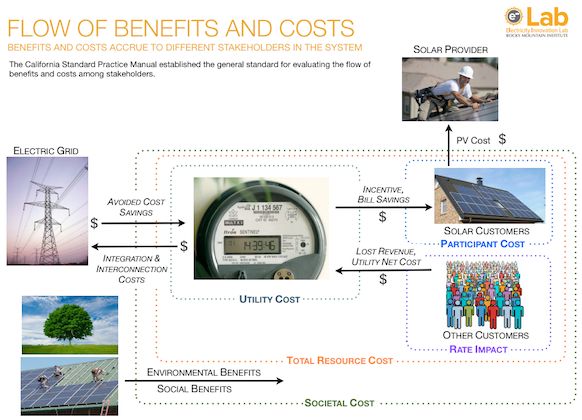The report A Review of Solar PV Benefit and Cost Studies from the Rocky Mountain Institute (RMI) is an analysis of fifteen studies on the value of distributed photovoltaic solar. Some of the studies were commissioned by utilities, some by solar advocacy groups, and some came from independent government or non-government researchers.
“We are on the cusp of needing a new methodology for how to integrate distributed energy resources into our planning,” explained RMI Senior Consultant Virginia Lacy. She and co-author/RMI principal Lena Hansen set out to assess “the knowns and unknowns” about categories and best practices that define the value of distributed energy resources, and especially of distributed PV, as well as the variables that contribute to the tensions between distributed generators and utilities.
“As we move into a world of customer-sited electricity, led strongly by distributed PV, it is critical to better understand the benefits and costs,” Lacy said, “to enable effective tradeoffs between distributed and centralized investments.”
For solar advocates, utility leaders and regulators, Lacy said, “The biggest takeaway is that there are important gaps in the approach for identifying, quantifying, and assessing the benefits and costs of distributed PV.”

The even-handed analysis makes clear how much agreement there is on distributed PV’s energy value. But it also reveals how little agreement there is on distributed PV’s capacity value, which is its ability to offset the need for investments in wires or generation.
“You keep hearing that even with distributed PV, the utility needs to recover fixed costs,” Lacy said. “It is less challenging to attribute an avoided cost, or an energy value, to distributed PV because we have 30 years of experience.” A resource’s avoided cost was part of the PURPA evaluation procedure introduced in 1978, she said.
“To calculate a capacity value and conclude that solar can displace transmission or distribution and lead to a lower cost system overall,” Lacy explained, “utilities need to know solar will be producing power when the system needs it.”
One of the significant differences in the studies Lacy and Hansen analyzed from the utility industry and the solar industry, Lacy said, is their respective conclusions about whether distributed PV can offset transmission and distribution system investments.
Solar is only beginning to reach grid penetration levels at which conclusions can be substantive on this issue, Lacy said. Typically, studies have shown that distributed PV could eventually defer these needs, but new infrastructure would remain a necessity for at least ten years, and even then, there would only be enough distributed PV megawatts for planners to defer perhaps 15 percent of projected infrastructure needs.
In recent years, distributed PV has grown enormously, but it is still “a novelty” to regulators and utility planners, Lacy said.

Source: Rocky Mountain Institute
Planners have to see the distribution system as delivering generation the same way they now see the transmission system as delivering it, Lacy said. “Otherwise, we will hit a point where there is overinvestment in unneeded infrastructure and we will run into operational issues because we are still essentially blind to everything beyond the substation.”
“We don’t get to choose whether or not we change,” Lacy said. “It is happening. The market is speaking. And that’s a great thing. We have an opportunity to provide more customer choice and utilities can be a part of that.”
It is also important for planners at state and federal commissions “to recognize and understand the benefits and costs of distributed PV,” Lacy said. ““Regulators are there to make sure the utility can pursue that opportunity when it is in the best interest of ratepayers or the public they serve."
Utilities and regulators have traditionally thought in terms of building supply to meet demand, Lacy said. “Supply could be ramped and demand had to be met. Demand was the source of variability and uncertainty.”
With distributed generation, and especially with distributed PV, that situation is reversed. “These things completely change the paradigm,” Lacy acknowledged. And it is happening really fast for a system which for a century has been based on central generation, she added.
“There are real challenges in doing the technical evaluation of solar and other generation on the customer side of the meter that planners need,” Lacy said. “But we have sent a man to the moon. This is not a game-stopper. We are going to have to employ new methods that will lead to more informed decisions.”

Source: Rocky Mountain Institute



